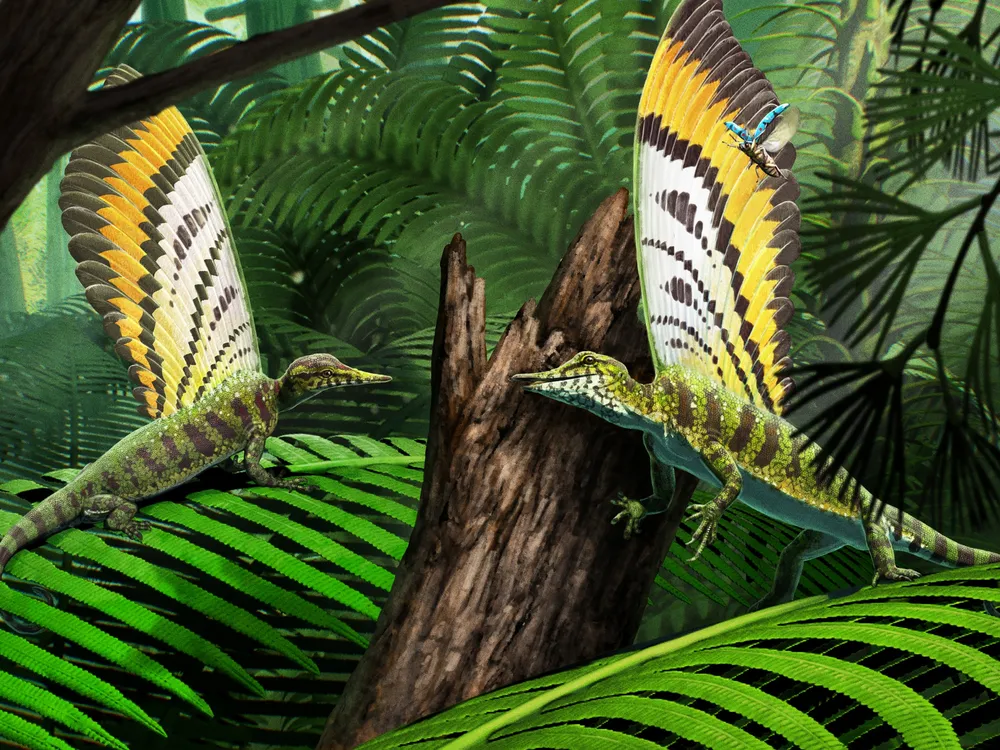Paleontologists Discover a ‘Marvelous’ Triassic Reptile That Sported a Sail of Feather-Like Structures on its Back
The odd structure is distinct from anything seen in living animals and likely created a colorful display

During the Triassic period nearly 250 million years ago, a small reptile scurried after insects in the canopy of a lush forest. The creature, which could fit snugly inside the palm of a hand, looked like a lizard, save for one striking feature: a soaring sail of feather-like structures that resembled a well-coiffed pompadour.
This odd structure is unlike any structure seen on living animals today according to Hans Sues, a senior scientist in the department of paleobiology at the National Museum of Natural History. “The new discovery shows that there’s this entirely new body plan among reptiles that evolved early in the Triassic,” he said.
In a study published today in the journal Nature, Sues and his colleagues described the ancient reptile, which also had a barrel-shaped body and an elongated beak-like snout. They placed the animal in the new genus Mirasaura, which means ‘marvelous reptile’ and adorned it with the species name grauvogeli to honor its discoverer, fossil collector Louis Grauvogel.
Grauvogel uncovered multiple Mirasaura specimens while exploring sandstone quarries in eastern France. The local rocks are part of the Grès à Voltzia Formation, which dates back to the Middle Triassic. Some 247 million years ago, this area was a river delta fringed by dense forests of conifers.
/https://tf-cmsv2-smithsonianmag-media.s3.amazonaws.com/filer_public/43/e1/43e1ff6e-73a1-49a6-b1ec-ac1fbed06218/h_sues_smns_may_2025.jpeg)
The Grès à Voltzia fossils preserve a snapshot of a poorly known chapter of the Triassic that occurred just a few million years after the end Permian mass extinction, the most severe extinction event in Earth’s history.
The Stuttgart State Museum of Natural History acquired Grauvogel’s trove of Triassic fossils between 2017 and 2020. Grauvogel and his daughter, paleobotanist Léa Grauvogel-Stamm, carefully curated their sprawling collection which contained everything from fossilized leaves to imprints of ancient spiders and insects, some of which are so well-preserved that they retain traces of color.
Grauvogel also uncovered parts of two small reptile skeletons. Sues, who specializes in studying the early evolution of reptiles and often collaborates with researchers in Stuttgart, was intrigued. “Immediately my ears perked up and we began looking for these little Triassic reptiles,” he said.
One of the fossils flummoxed the researchers. It was preserved on a slab of rock with what looked like a leaf protruding out of its back. Initially, the team thought that the leafy material was fossilized alongside the animal at the bottom of a local river.
/https://tf-cmsv2-smithsonianmag-media.s3.amazonaws.com/filer_public/88/71/8871d28c-5873-494b-a768-3c12a06d0a72/pic_2_-_holotype_mirasaura_grauvogeli_copyright_stephan_spiekman.jpg)
However, as the team dug through more of the fossils, they uncovered similar leaf-like structures. This prompted the researchers to take a closer look at the initial reptile fossil. Sure enough, the odd structure was attached to the backbone of the tiny skeleton.
/https://tf-cmsv2-smithsonianmag-media.s3.amazonaws.com/filer_public/a4/f1/a4f10aae-1190-4234-aacc-d864009fe85a/pic_5_-_mirasaura_crest_copyright_stephan_spiekman.jpg)
One of Sues’s colleagues, Stephan Spiekman, a paleontologist at the Stuttgart museum and the lead author of the new paper, analyzed the specimen for his postdoctoral studies. He took the fossil to France, where it was scanned by a specialized particle accelerator known as a synchrotron. This created digital slices of the delicate skeleton. Spiekman then pieced together these scans to visualize the animal’s odd anatomy in three dimensions.
This work revealed that Mirasaura belonged to an odd group of Triassic reptiles known as the drepanosauromorphs. While not closely related to modern reptiles, many of these ancient creatures resembled bizarrely proportioned lizards. For example, one species, Drepanosaurus, looked like a chameleon with a bony hook on its tail, hunched shoulders and a giant claw on its second finger.
During the Triassic, drepanosauromorphs lived alongside archosaurs, the group containing crocodiles, pterosaurs, dinosaurs and birds, and the ancestors of mammals. These groups were locked in an evolutionary battle for ecosystem supremacy and eventually developed features like endothermy (the ability to regulate the body’s internal temperature) and larger brain sizes. Many of these evolutionary milestones were linked to the development of skin features like fur and feathers, which kept the animals’ bodies warm.
Mirasaura reveals that other groups of animals were also experimenting with skin structures during the Triassic. The animal’s sail contained up to sixteen individual segments, which became progressively shorter as they traveled down the back. Each segment resembled a feather and even contained pigment-producing structures called melanosomes that help give birds their colorful plumage. However, the structures lining Mirasaura’s back are not actually feathers because they lack barbs and other key features.
/https://tf-cmsv2-smithsonianmag-media.s3.amazonaws.com/filer_public/bc/11/bc118d74-5527-460b-a397-0b6ef94856f2/pic_6_-_skeletal_reconstruction_mirasaura_copyright_stephan_spiekman.jpg)
Instead, Mirasaura sported a skin structure unlike anything seen in modern animals. But it likely was not radically different from what other animals at the time were wearing. “Hair, feathers and scales all have a common developmental path because there’s similar underlying genes that control them,” Sues said. “So they're all very similar structures.”
The function of Mirasaura’s sail-like structure remains a mystery. Because the segments contained melanosomes, it was likely that they created a colorful display to attract mates or deter rivals and predators. Sues posits that they may have also helped the creature camouflage among its environment.
Similar structures are seen in another Triassic reptile called Longisquama. This enigmatic creature is known from a set of fossils found in Kyrgyzstan and sported a fan of hockey stick-shaped structures that stuck out of its back.
Mirasaura reveals that these odd structures may have been in vogue amongst several Triassic reptiles. “It’s no longer a one off,” Sues said. “There must have been a whole bunch of these little reptiles that had these peculiar structures.”

